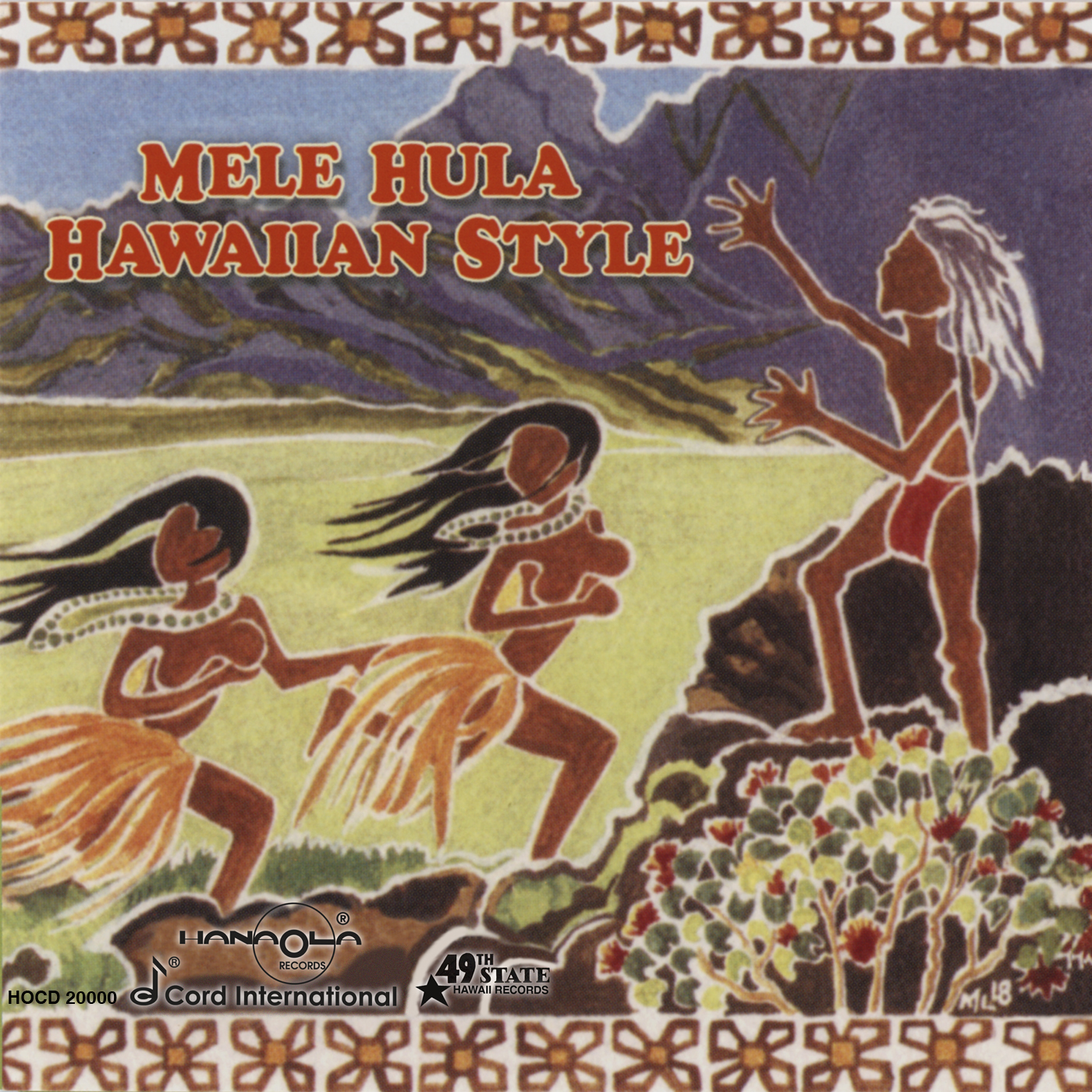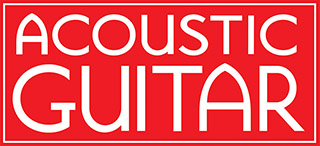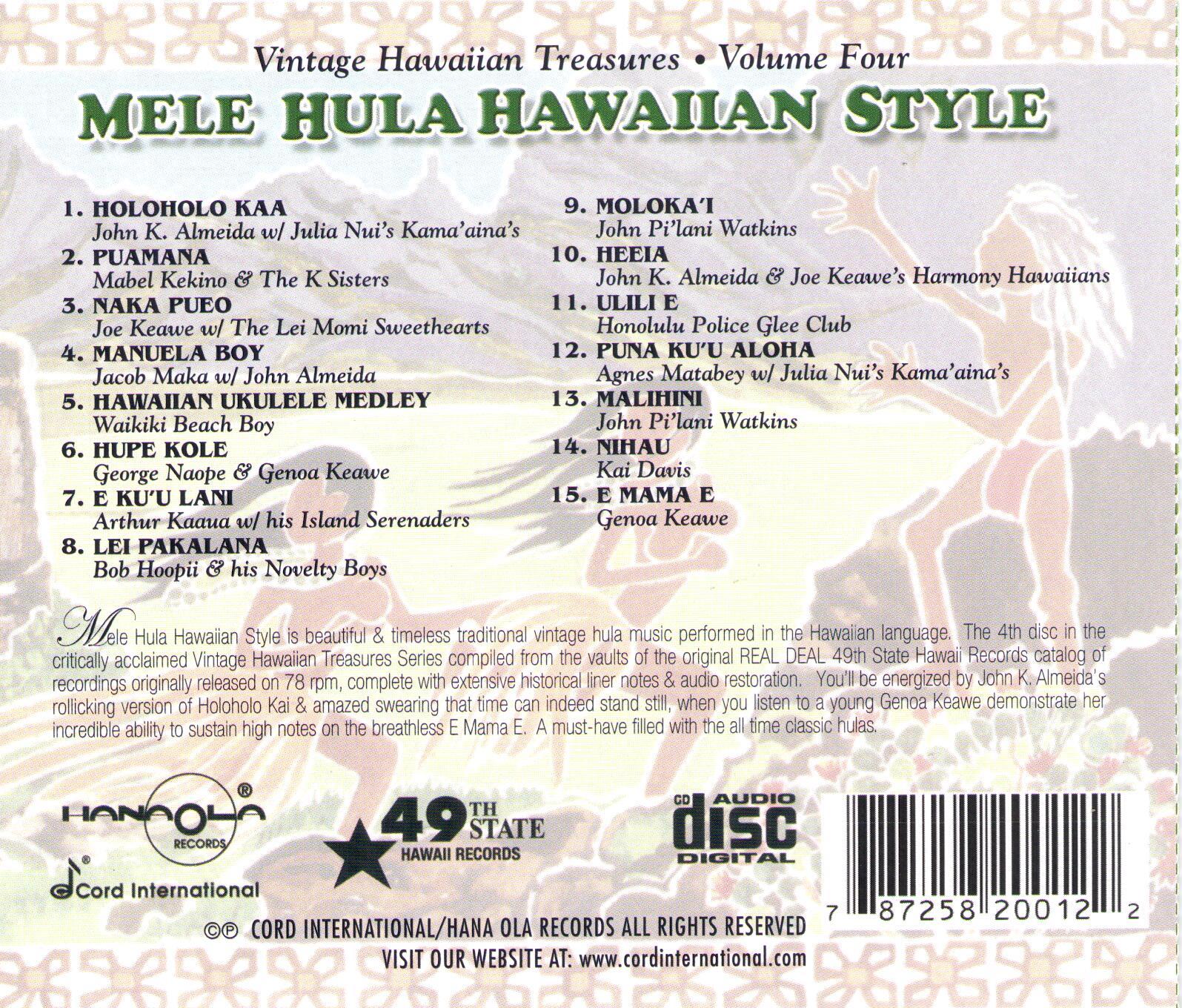

 |
 |
 |
| Download CD NOW | Listen on YouTube | Shipping to USA addresss ONLY |
Mele Hula Hawaiian Style is beautiful timeless traditional vintage hula music performed in the Hawaiian language. The 4th disc in the critically acclaimed Vintage Hawaiian Treasures Series compiled from the vaults of the original REAL DEAL 49th State Hawaii Records catalog of recordings originally released on 78 rpm, complete with extensive historical liner notes and audio restoration. You’ll be energized by John K. Almeida’s rollicking version of Holoholo Kai and amazed, swearing that time can indeed stand still, when you listen to a young Genoa Keawe demonstrate her ability to sustain high falsetto notes on the breathless E Mama E. A must-have filled with classic timeless hula. |

This collection [Mele Hula - Hawaiian Style: Vintage Hawaiian Treasures, Vol. 4] of recordings from the decade following World War II encompasses everything from modernized chant to hula tunes to pop-influenced hapa haole (half-white) ditties. The ensembles feature slack-key and steel guitars, ukulele, and bass in support of some lovely falsetto singing, notably by John K. Almeida (who also produced the original sessions) and the incredible Genoa Keawe. In both repertoire and feeling, this material provides a context for more guitar-centered slack-key music, and it's great listening in its own right. |
Acoustic Guitar HIT LIST February 1997 - Russell Letson |
Vintage Hawaiian Treasures - Volume Four - Mele Hula - Hawaiian Style In the last century, generations of Hawaiian performers have embraced the musical traditions of hula and mele. This traditional Hawaiian music has been lovingly passed on from generation to generation, preserving Hawaii's rich cultural heritage. Mele hula ku'i represents the evolution of the original Mele Hula to a Westernized style of dance and chant, which now is often sung. Vocalists may also sing in the uniquely Hawaiian falsetto style, either as a soloist or in harmony with a group. Hula Ku'i refers to Hawaiian hula songs of the late 19th and 20th century. These songs are uniquely Hawaiian by featuring a Hawaiian language text, correct pronunciation and a specific quality of voice and musical expression. Typically, the composition expresses praise for subject individuals, places, and events. And the use of kaona, or hidden meaning, is common. The basic framework of the hula is melody and rhythm enhanced by vocal harmony and traditional instruments. Beyond this basic framework is the element of individual stylistic expression. This improvisational technique in the performance of Hawaiian music reflects a respectful knowledge of Hawaiian tradition. Traditional Hawaiian music includes an ensemble of guitar, ukulele, bass, steel guitar and an interrelationship between these instruments, the performing artists, and the hula. This music represents a primary vehicle of Hawaii's rich cultural expression. At the end of World War II, George K. Ching began recording Hawaiian music on his new record label, 49th State Hawaii Records. 49th State was so named because many businessmen were anticipating Hawaii's eventual attainment of statehood. However, no one realized then that Alaska would actually gain that distinction, and Hawaii would end up as the 50th state. Ching wanted to manufacture Hawaiian records to answer the demand for music in his downtown Honolulu record store. To guarantee authenticity in the recording performances, Ching enlisted John Kameaaloha Almeida, known today as the Dean of Hawaiian Music, as the label's musical director. Over the next decade, 49th State Hawaii Records recorded and released an enormous catalog of Hawaiian musical expression. Traditional Hawaiian chant and hula, hapa-haole songs, and even the music from the rest of Polynesia, were recorded by a stable of aspiring local talent, all under the guiding hand of John K. Almeida. The first 49th State recordings were made using an acetate record cutting machine in a make-shift studio at Ching's own home. When the technology became available, a tape recorder was used recording first on paper tapes and then later on plastic. The original recordings were released first on 78 rpm records. With this Vintage Hawaiian Treasures Series Hana Ola Records shares with you a collection of Mele Hula Hawaiian Style. These are the original 49th State recordings performed by a variety of the label's gifted artists in the unique style that makes the music unquestionably authentically Hawaiian. HOLOHOLO KAA: PUAMANA: NAKA PUEO: MANUELA BOY: HAWAIIAN UKULELE MEDLEY: HUPE KOLE: E KU'U LANI: LEI PAKALANA: MOLOKA'I: HEEIA: ULILI E: PUNA KU'U ALOHA: MALIHINI: NIIHAU: E MAMA E: |

HOCD 20000 - Vintage Hawaiian Treasures - Volume Four - Mele Hula - Hawaiian Style
